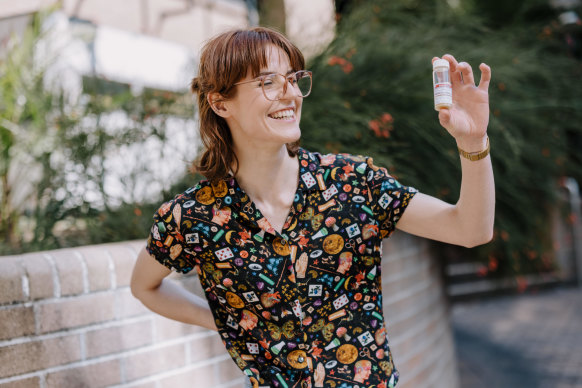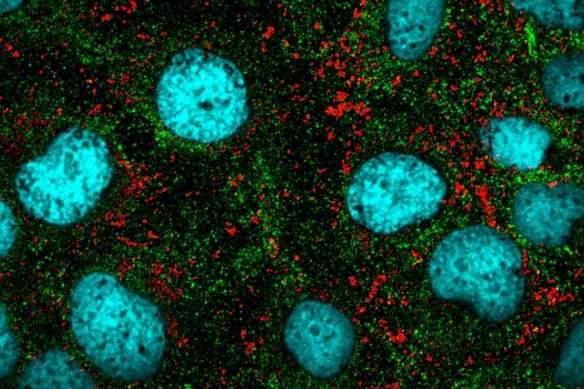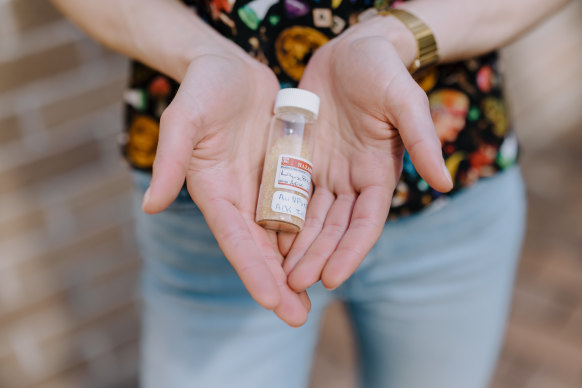By Angus Dalton
Tiny crystals could be injected into tumours and heated by a magnetic field to “cook” cancer cells deep within the brain, according to scientists researching the potential of the tumour-killing particles.
Sydney physics student Alice O’Keefe is developing a new type of magnetic nanoparticle for her PhD at the University of Wollongong. Her high-tech particles look like “dirt”.

Alice O’Keefe is a PhD student at the University of Wollongong developing tiny crystals that can heat up and kill brain cancer cells. Credit: Michael Gray
“But the ‘dirt’ is made up of tiny little crystal grains like salt,” she said. “The lattice structure of the small crystals allows for this magnetic property that I’m leveraging for a new type of heat-based cancer treatment.”
The method, called magnetic hyperthermia, has been investigated for years as a way to attack difficult brain cancers.
Some tumours spread “tentacles” into brain tissue that can’t be removed by surgery, and the blood-brain barrier obstructs the delivery of chemotherapy drugs. Treatment in some cases can risk damaging areas of the brain responsible for mood, personality and memory.
That’s why O’Keefe and her colleagues from the university’s Centre for Medical Radiation Physics are designing nanoparticles that zero in on cancer cells and spare healthy brain tissue.

In another study into nanoparticles and cancer, UK scientists coated gold nanoparticles (shown in red) with chemotherapy drugs so they could precisely target cancer cells (blue/green areas).Credit: National Heart and Lung Institute, Imperial College London
“You inject the nanoparticles into the brain, directly into the tumour. And cancer cells are basically just greedier versions of normal cells, so they will eat up the nanoparticles before the healthy tissue gets to them,” she said.
A magnetic field would then excite the nanoparticles, generating heat to kill the cancer.
This method relies on two key factors: cancer cells die at a slightly lower temperature than normal cells. And magnetic materials lose their magnetism when they hit a certain temperature called the “Curie point”.
With the right Curie point, nanoparticles could grow hot enough to cook cancer and then “switch off” without overheating the rest of the brain.
“I’m making nanoparticles that demagnetise at a temperature that is above the temperature to damage the cancer, but below a temperature that damages the healthy cells,” O’Keefe said.

The nanoparticles resemble “dirt” but could one day kill brain cancer cells.Credit: Michael Gray
She’s aiming for a Curie point between 42 and 47 degrees. At the lower end of that range, the heated nanoparticles make tumours more vulnerable to chemotherapy and radiation. At temperatures over 45 degrees, the heat could kill cancer cells directly.
It’s very early-stage research, although recent scientific reviews have urged for funding of more clinical trials after the magnetic hyperthermia therapy demonstrated “excellent therapeutic efficacy” in pre-clinical studies.
On Thursday evening, O’Keefe will compete as a NSW finalist in FameLab, the largest science communication competition in the world. She’ll go head-to-head with 11 other scientists spruiking their research in a three-minute pitch, sans PowerPoint slides.
The clearest and most charismatic researcher will progress to the international competition in November.
O’Keefe was inspired to study physics after becoming obsessed with magnets as a nine-year-old when her parents made one of the “magic rocks” dance by itself across the dining table. Now she’s focused on getting others enthused about science too.
“Your research can only go so far if people don’t know about it,” she said.
The Examine newsletter explains and analyses science with a rigorous focus on the evidence. Sign up to get it each week.